ACC202 Corporate Accounting: Relevance of Fair Value in Modern World
VerifiedAdded on 2023/01/11
|9
|1877
|25
Essay
AI Summary
This essay critically examines the relevance of fair value accounting in the contemporary world, addressing its applicability across private and public sector organizations and its potential influence on financial crises. It begins by defining fair value accounting and discussing its relevance, highlighting the challenges and debates surrounding its reliability, particularly in markets lacking liquidity. The essay then explores the scope of fair value accounting under current accounting standards, emphasizing its use in investment property, financial instruments, and business combinations. Furthermore, it analyzes the impact of fair value accounting on financial crises, considering controversies and implementation issues. Finally, the essay includes case studies of Woolworths and Wesfarmers, analyzing how these companies apply fair value measurement in their financial reporting, specifically in areas like revenue, financial assets, goodwill, intangible assets, and liabilities. The essay concludes by referencing academic and professional research articles to support its arguments and analysis.
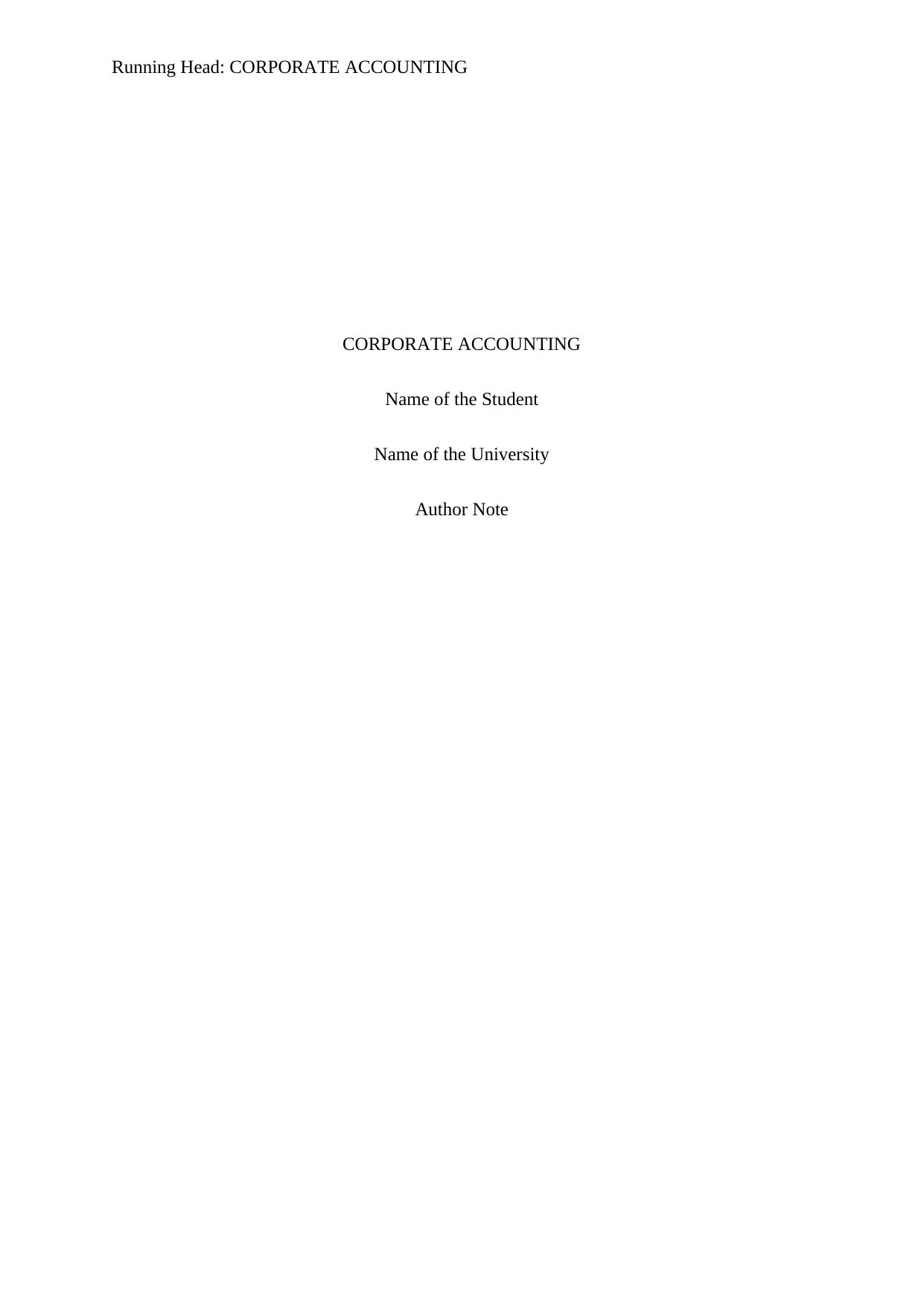
Running Head: CORPORATE ACCOUNTING
CORPORATE ACCOUNTING
Name of the Student
Name of the University
Author Note
CORPORATE ACCOUNTING
Name of the Student
Name of the University
Author Note
Paraphrase This Document
Need a fresh take? Get an instant paraphrase of this document with our AI Paraphraser
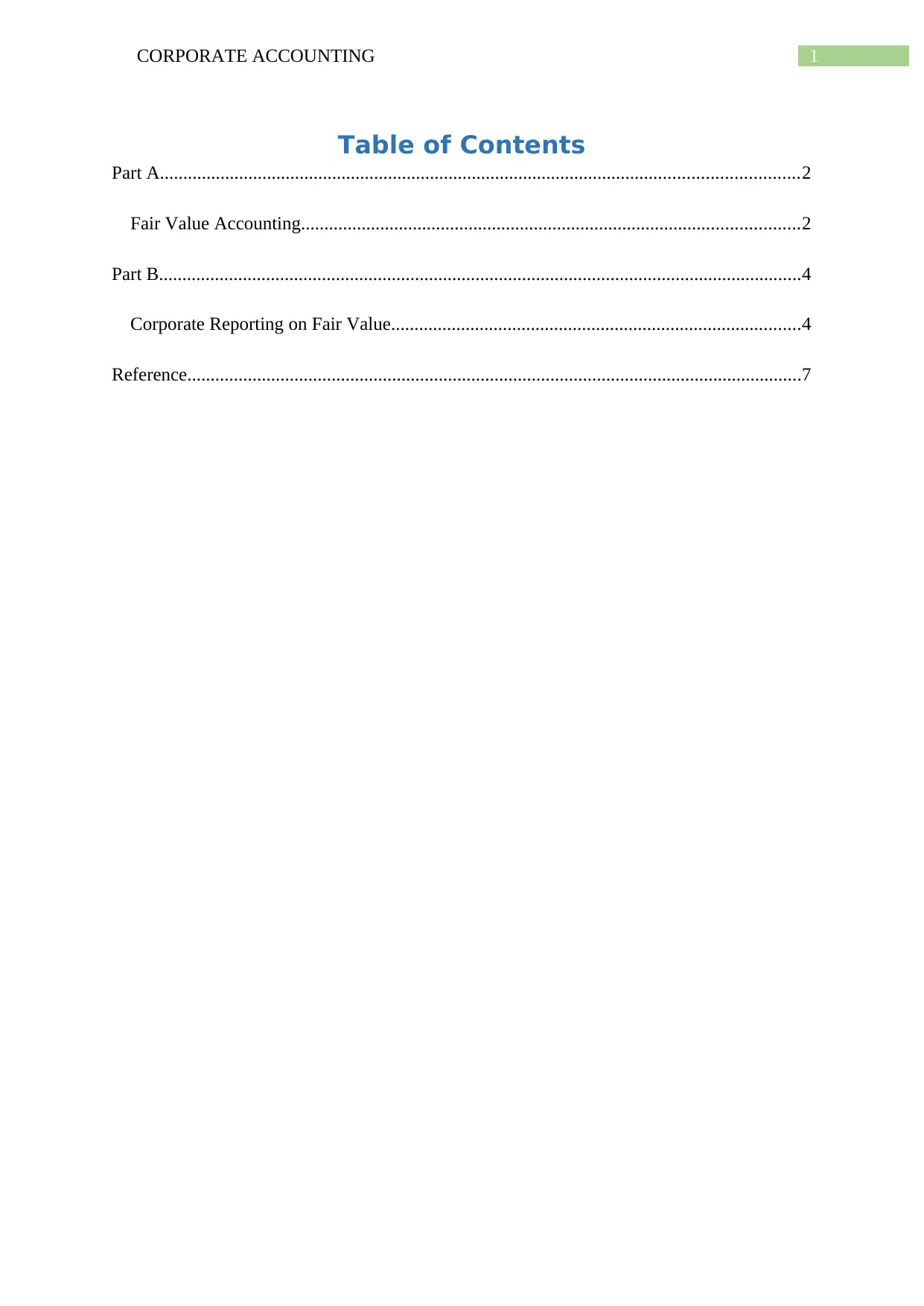
1CORPORATE ACCOUNTING
Table of Contents
Part A.........................................................................................................................................2
Fair Value Accounting...........................................................................................................2
Part B..........................................................................................................................................4
Corporate Reporting on Fair Value........................................................................................4
Reference....................................................................................................................................7
Table of Contents
Part A.........................................................................................................................................2
Fair Value Accounting...........................................................................................................2
Part B..........................................................................................................................................4
Corporate Reporting on Fair Value........................................................................................4
Reference....................................................................................................................................7
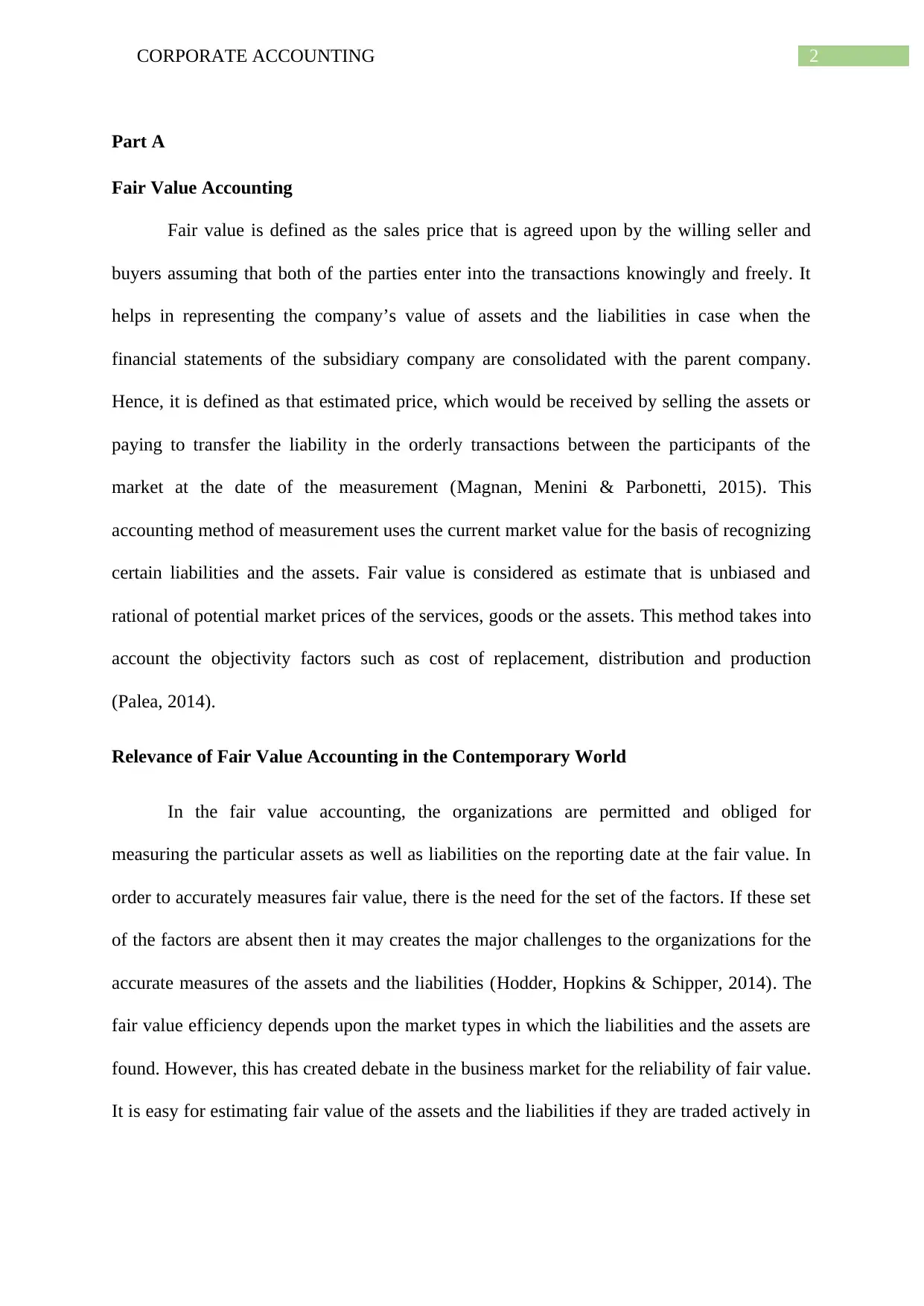
2CORPORATE ACCOUNTING
Part A
Fair Value Accounting
Fair value is defined as the sales price that is agreed upon by the willing seller and
buyers assuming that both of the parties enter into the transactions knowingly and freely. It
helps in representing the company’s value of assets and the liabilities in case when the
financial statements of the subsidiary company are consolidated with the parent company.
Hence, it is defined as that estimated price, which would be received by selling the assets or
paying to transfer the liability in the orderly transactions between the participants of the
market at the date of the measurement (Magnan, Menini & Parbonetti, 2015). This
accounting method of measurement uses the current market value for the basis of recognizing
certain liabilities and the assets. Fair value is considered as estimate that is unbiased and
rational of potential market prices of the services, goods or the assets. This method takes into
account the objectivity factors such as cost of replacement, distribution and production
(Palea, 2014).
Relevance of Fair Value Accounting in the Contemporary World
In the fair value accounting, the organizations are permitted and obliged for
measuring the particular assets as well as liabilities on the reporting date at the fair value. In
order to accurately measures fair value, there is the need for the set of the factors. If these set
of the factors are absent then it may creates the major challenges to the organizations for the
accurate measures of the assets and the liabilities (Hodder, Hopkins & Schipper, 2014). The
fair value efficiency depends upon the market types in which the liabilities and the assets are
found. However, this has created debate in the business market for the reliability of fair value.
It is easy for estimating fair value of the assets and the liabilities if they are traded actively in
Part A
Fair Value Accounting
Fair value is defined as the sales price that is agreed upon by the willing seller and
buyers assuming that both of the parties enter into the transactions knowingly and freely. It
helps in representing the company’s value of assets and the liabilities in case when the
financial statements of the subsidiary company are consolidated with the parent company.
Hence, it is defined as that estimated price, which would be received by selling the assets or
paying to transfer the liability in the orderly transactions between the participants of the
market at the date of the measurement (Magnan, Menini & Parbonetti, 2015). This
accounting method of measurement uses the current market value for the basis of recognizing
certain liabilities and the assets. Fair value is considered as estimate that is unbiased and
rational of potential market prices of the services, goods or the assets. This method takes into
account the objectivity factors such as cost of replacement, distribution and production
(Palea, 2014).
Relevance of Fair Value Accounting in the Contemporary World
In the fair value accounting, the organizations are permitted and obliged for
measuring the particular assets as well as liabilities on the reporting date at the fair value. In
order to accurately measures fair value, there is the need for the set of the factors. If these set
of the factors are absent then it may creates the major challenges to the organizations for the
accurate measures of the assets and the liabilities (Hodder, Hopkins & Schipper, 2014). The
fair value efficiency depends upon the market types in which the liabilities and the assets are
found. However, this has created debate in the business market for the reliability of fair value.
It is easy for estimating fair value of the assets and the liabilities if they are traded actively in
⊘ This is a preview!⊘
Do you want full access?
Subscribe today to unlock all pages.

Trusted by 1+ million students worldwide
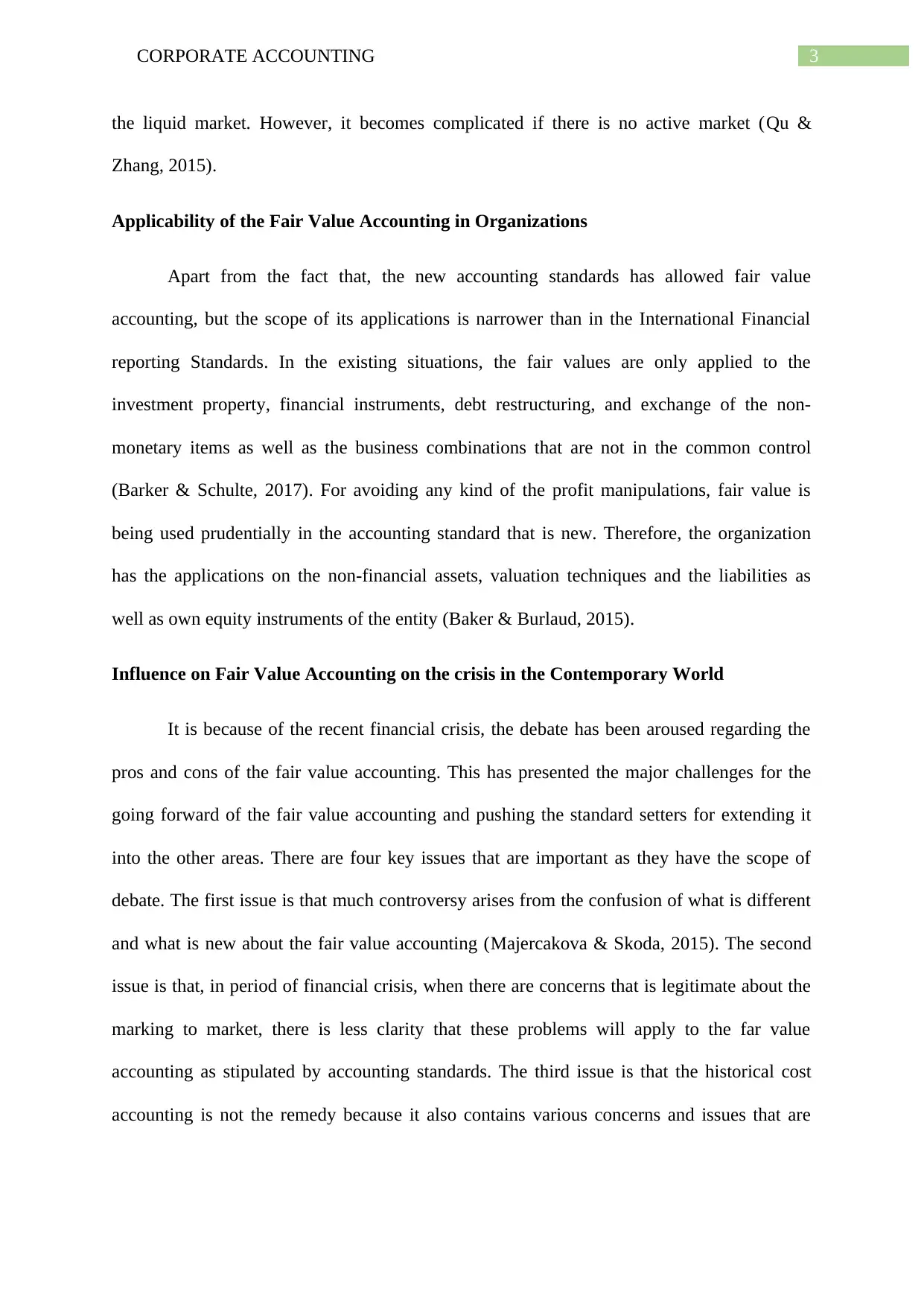
3CORPORATE ACCOUNTING
the liquid market. However, it becomes complicated if there is no active market (Qu &
Zhang, 2015).
Applicability of the Fair Value Accounting in Organizations
Apart from the fact that, the new accounting standards has allowed fair value
accounting, but the scope of its applications is narrower than in the International Financial
reporting Standards. In the existing situations, the fair values are only applied to the
investment property, financial instruments, debt restructuring, and exchange of the non-
monetary items as well as the business combinations that are not in the common control
(Barker & Schulte, 2017). For avoiding any kind of the profit manipulations, fair value is
being used prudentially in the accounting standard that is new. Therefore, the organization
has the applications on the non-financial assets, valuation techniques and the liabilities as
well as own equity instruments of the entity (Baker & Burlaud, 2015).
Influence on Fair Value Accounting on the crisis in the Contemporary World
It is because of the recent financial crisis, the debate has been aroused regarding the
pros and cons of the fair value accounting. This has presented the major challenges for the
going forward of the fair value accounting and pushing the standard setters for extending it
into the other areas. There are four key issues that are important as they have the scope of
debate. The first issue is that much controversy arises from the confusion of what is different
and what is new about the fair value accounting (Majercakova & Skoda, 2015). The second
issue is that, in period of financial crisis, when there are concerns that is legitimate about the
marking to market, there is less clarity that these problems will apply to the far value
accounting as stipulated by accounting standards. The third issue is that the historical cost
accounting is not the remedy because it also contains various concerns and issues that are
the liquid market. However, it becomes complicated if there is no active market (Qu &
Zhang, 2015).
Applicability of the Fair Value Accounting in Organizations
Apart from the fact that, the new accounting standards has allowed fair value
accounting, but the scope of its applications is narrower than in the International Financial
reporting Standards. In the existing situations, the fair values are only applied to the
investment property, financial instruments, debt restructuring, and exchange of the non-
monetary items as well as the business combinations that are not in the common control
(Barker & Schulte, 2017). For avoiding any kind of the profit manipulations, fair value is
being used prudentially in the accounting standard that is new. Therefore, the organization
has the applications on the non-financial assets, valuation techniques and the liabilities as
well as own equity instruments of the entity (Baker & Burlaud, 2015).
Influence on Fair Value Accounting on the crisis in the Contemporary World
It is because of the recent financial crisis, the debate has been aroused regarding the
pros and cons of the fair value accounting. This has presented the major challenges for the
going forward of the fair value accounting and pushing the standard setters for extending it
into the other areas. There are four key issues that are important as they have the scope of
debate. The first issue is that much controversy arises from the confusion of what is different
and what is new about the fair value accounting (Majercakova & Skoda, 2015). The second
issue is that, in period of financial crisis, when there are concerns that is legitimate about the
marking to market, there is less clarity that these problems will apply to the far value
accounting as stipulated by accounting standards. The third issue is that the historical cost
accounting is not the remedy because it also contains various concerns and issues that are
Paraphrase This Document
Need a fresh take? Get an instant paraphrase of this document with our AI Paraphraser
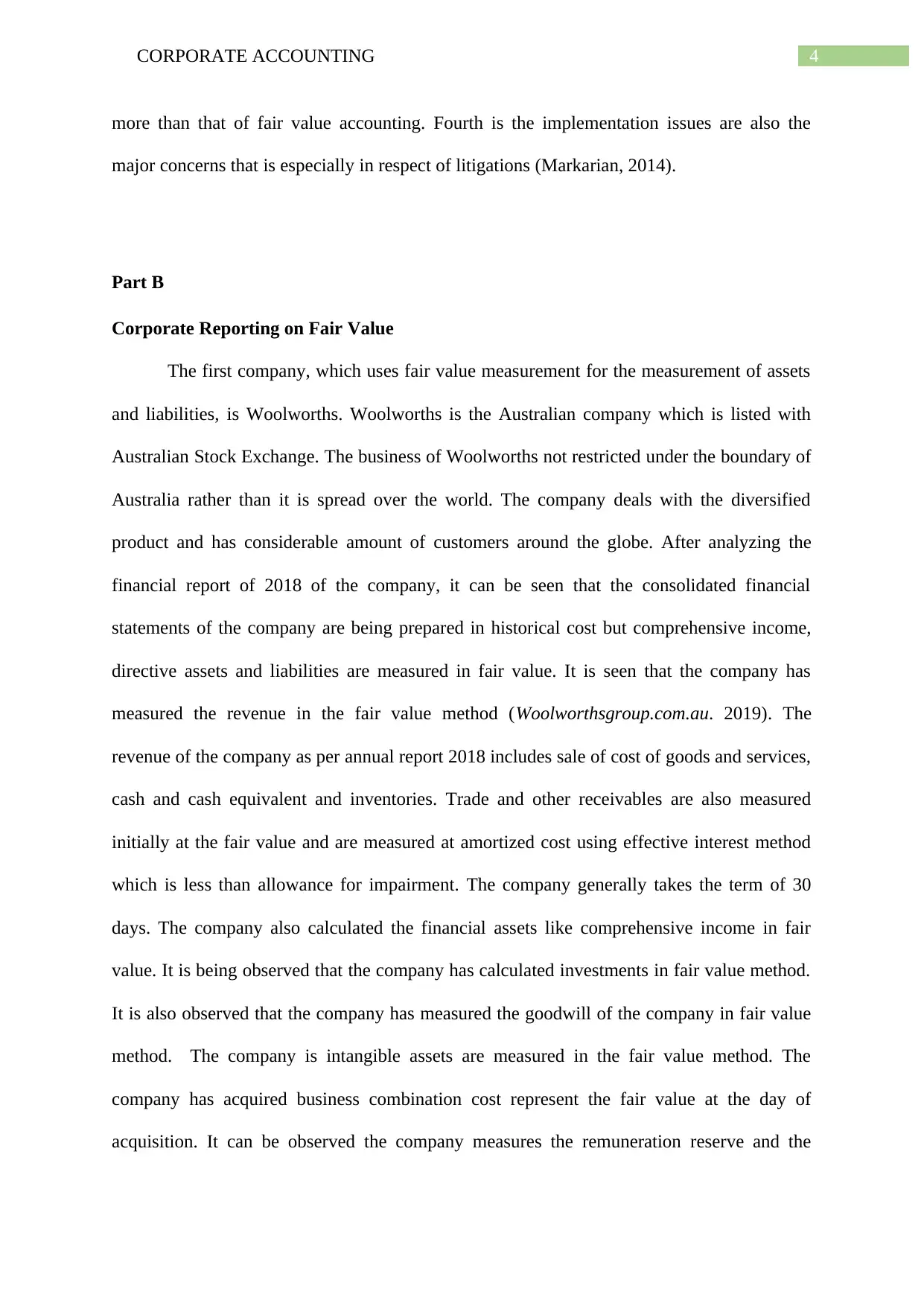
4CORPORATE ACCOUNTING
more than that of fair value accounting. Fourth is the implementation issues are also the
major concerns that is especially in respect of litigations (Markarian, 2014).
Part B
Corporate Reporting on Fair Value
The first company, which uses fair value measurement for the measurement of assets
and liabilities, is Woolworths. Woolworths is the Australian company which is listed with
Australian Stock Exchange. The business of Woolworths not restricted under the boundary of
Australia rather than it is spread over the world. The company deals with the diversified
product and has considerable amount of customers around the globe. After analyzing the
financial report of 2018 of the company, it can be seen that the consolidated financial
statements of the company are being prepared in historical cost but comprehensive income,
directive assets and liabilities are measured in fair value. It is seen that the company has
measured the revenue in the fair value method (Woolworthsgroup.com.au. 2019). The
revenue of the company as per annual report 2018 includes sale of cost of goods and services,
cash and cash equivalent and inventories. Trade and other receivables are also measured
initially at the fair value and are measured at amortized cost using effective interest method
which is less than allowance for impairment. The company generally takes the term of 30
days. The company also calculated the financial assets like comprehensive income in fair
value. It is being observed that the company has calculated investments in fair value method.
It is also observed that the company has measured the goodwill of the company in fair value
method. The company is intangible assets are measured in the fair value method. The
company has acquired business combination cost represent the fair value at the day of
acquisition. It can be observed the company measures the remuneration reserve and the
more than that of fair value accounting. Fourth is the implementation issues are also the
major concerns that is especially in respect of litigations (Markarian, 2014).
Part B
Corporate Reporting on Fair Value
The first company, which uses fair value measurement for the measurement of assets
and liabilities, is Woolworths. Woolworths is the Australian company which is listed with
Australian Stock Exchange. The business of Woolworths not restricted under the boundary of
Australia rather than it is spread over the world. The company deals with the diversified
product and has considerable amount of customers around the globe. After analyzing the
financial report of 2018 of the company, it can be seen that the consolidated financial
statements of the company are being prepared in historical cost but comprehensive income,
directive assets and liabilities are measured in fair value. It is seen that the company has
measured the revenue in the fair value method (Woolworthsgroup.com.au. 2019). The
revenue of the company as per annual report 2018 includes sale of cost of goods and services,
cash and cash equivalent and inventories. Trade and other receivables are also measured
initially at the fair value and are measured at amortized cost using effective interest method
which is less than allowance for impairment. The company generally takes the term of 30
days. The company also calculated the financial assets like comprehensive income in fair
value. It is being observed that the company has calculated investments in fair value method.
It is also observed that the company has measured the goodwill of the company in fair value
method. The company is intangible assets are measured in the fair value method. The
company has acquired business combination cost represent the fair value at the day of
acquisition. It can be observed the company measures the remuneration reserve and the
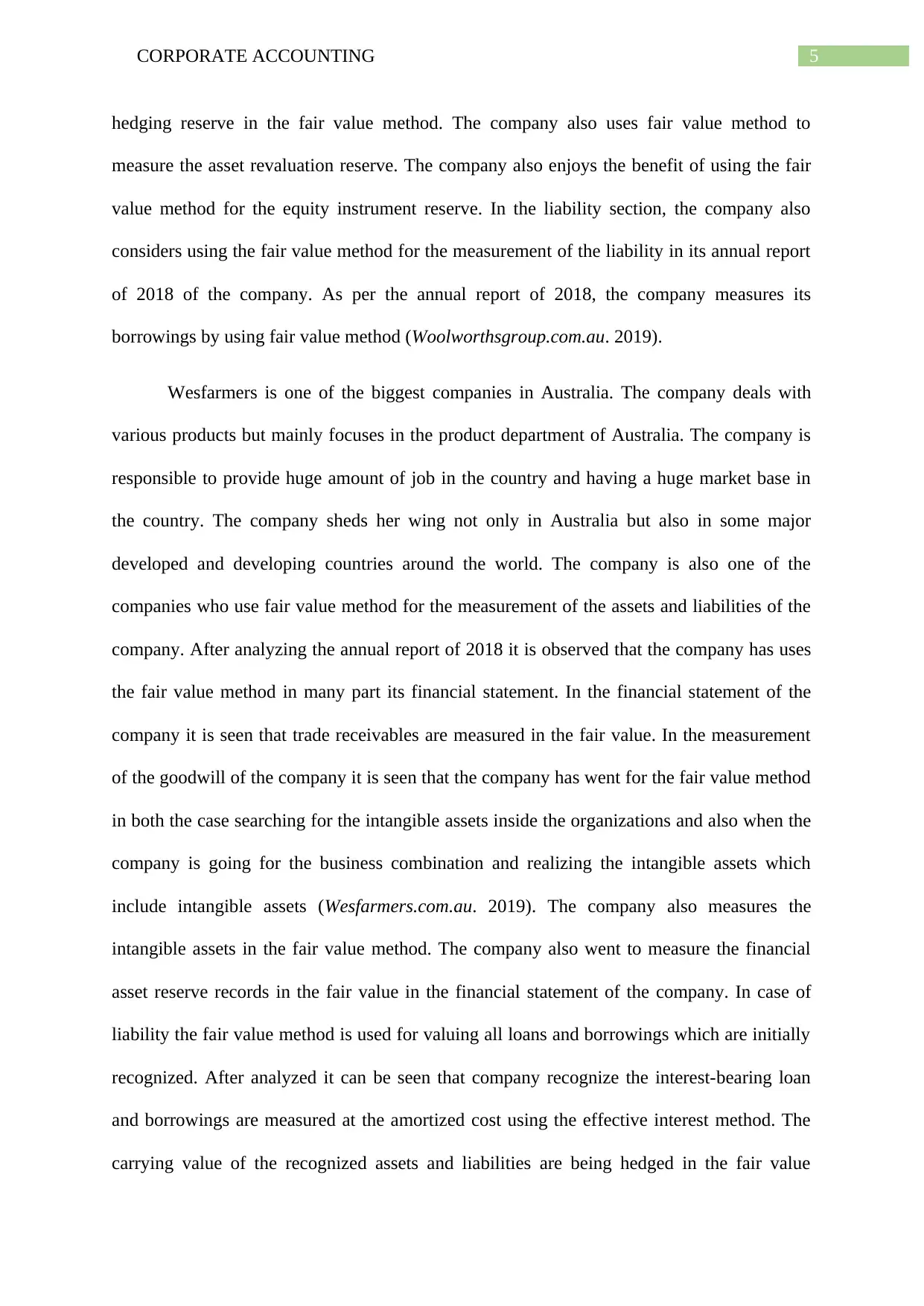
5CORPORATE ACCOUNTING
hedging reserve in the fair value method. The company also uses fair value method to
measure the asset revaluation reserve. The company also enjoys the benefit of using the fair
value method for the equity instrument reserve. In the liability section, the company also
considers using the fair value method for the measurement of the liability in its annual report
of 2018 of the company. As per the annual report of 2018, the company measures its
borrowings by using fair value method (Woolworthsgroup.com.au. 2019).
Wesfarmers is one of the biggest companies in Australia. The company deals with
various products but mainly focuses in the product department of Australia. The company is
responsible to provide huge amount of job in the country and having a huge market base in
the country. The company sheds her wing not only in Australia but also in some major
developed and developing countries around the world. The company is also one of the
companies who use fair value method for the measurement of the assets and liabilities of the
company. After analyzing the annual report of 2018 it is observed that the company has uses
the fair value method in many part its financial statement. In the financial statement of the
company it is seen that trade receivables are measured in the fair value. In the measurement
of the goodwill of the company it is seen that the company has went for the fair value method
in both the case searching for the intangible assets inside the organizations and also when the
company is going for the business combination and realizing the intangible assets which
include intangible assets (Wesfarmers.com.au. 2019). The company also measures the
intangible assets in the fair value method. The company also went to measure the financial
asset reserve records in the fair value in the financial statement of the company. In case of
liability the fair value method is used for valuing all loans and borrowings which are initially
recognized. After analyzed it can be seen that company recognize the interest-bearing loan
and borrowings are measured at the amortized cost using the effective interest method. The
carrying value of the recognized assets and liabilities are being hedged in the fair value
hedging reserve in the fair value method. The company also uses fair value method to
measure the asset revaluation reserve. The company also enjoys the benefit of using the fair
value method for the equity instrument reserve. In the liability section, the company also
considers using the fair value method for the measurement of the liability in its annual report
of 2018 of the company. As per the annual report of 2018, the company measures its
borrowings by using fair value method (Woolworthsgroup.com.au. 2019).
Wesfarmers is one of the biggest companies in Australia. The company deals with
various products but mainly focuses in the product department of Australia. The company is
responsible to provide huge amount of job in the country and having a huge market base in
the country. The company sheds her wing not only in Australia but also in some major
developed and developing countries around the world. The company is also one of the
companies who use fair value method for the measurement of the assets and liabilities of the
company. After analyzing the annual report of 2018 it is observed that the company has uses
the fair value method in many part its financial statement. In the financial statement of the
company it is seen that trade receivables are measured in the fair value. In the measurement
of the goodwill of the company it is seen that the company has went for the fair value method
in both the case searching for the intangible assets inside the organizations and also when the
company is going for the business combination and realizing the intangible assets which
include intangible assets (Wesfarmers.com.au. 2019). The company also measures the
intangible assets in the fair value method. The company also went to measure the financial
asset reserve records in the fair value in the financial statement of the company. In case of
liability the fair value method is used for valuing all loans and borrowings which are initially
recognized. After analyzed it can be seen that company recognize the interest-bearing loan
and borrowings are measured at the amortized cost using the effective interest method. The
carrying value of the recognized assets and liabilities are being hedged in the fair value
⊘ This is a preview!⊘
Do you want full access?
Subscribe today to unlock all pages.

Trusted by 1+ million students worldwide
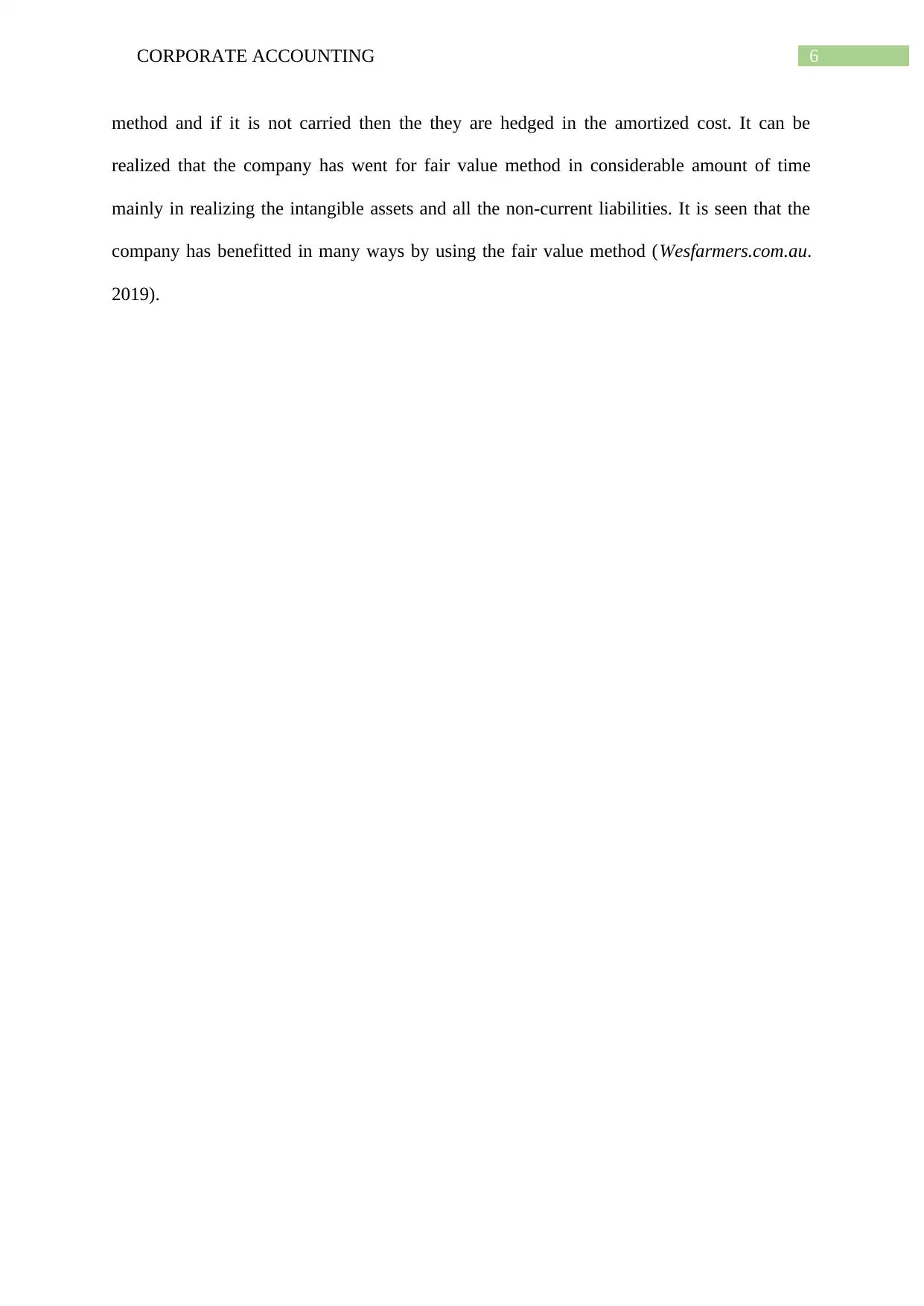
6CORPORATE ACCOUNTING
method and if it is not carried then the they are hedged in the amortized cost. It can be
realized that the company has went for fair value method in considerable amount of time
mainly in realizing the intangible assets and all the non-current liabilities. It is seen that the
company has benefitted in many ways by using the fair value method (Wesfarmers.com.au.
2019).
method and if it is not carried then the they are hedged in the amortized cost. It can be
realized that the company has went for fair value method in considerable amount of time
mainly in realizing the intangible assets and all the non-current liabilities. It is seen that the
company has benefitted in many ways by using the fair value method (Wesfarmers.com.au.
2019).
Paraphrase This Document
Need a fresh take? Get an instant paraphrase of this document with our AI Paraphraser
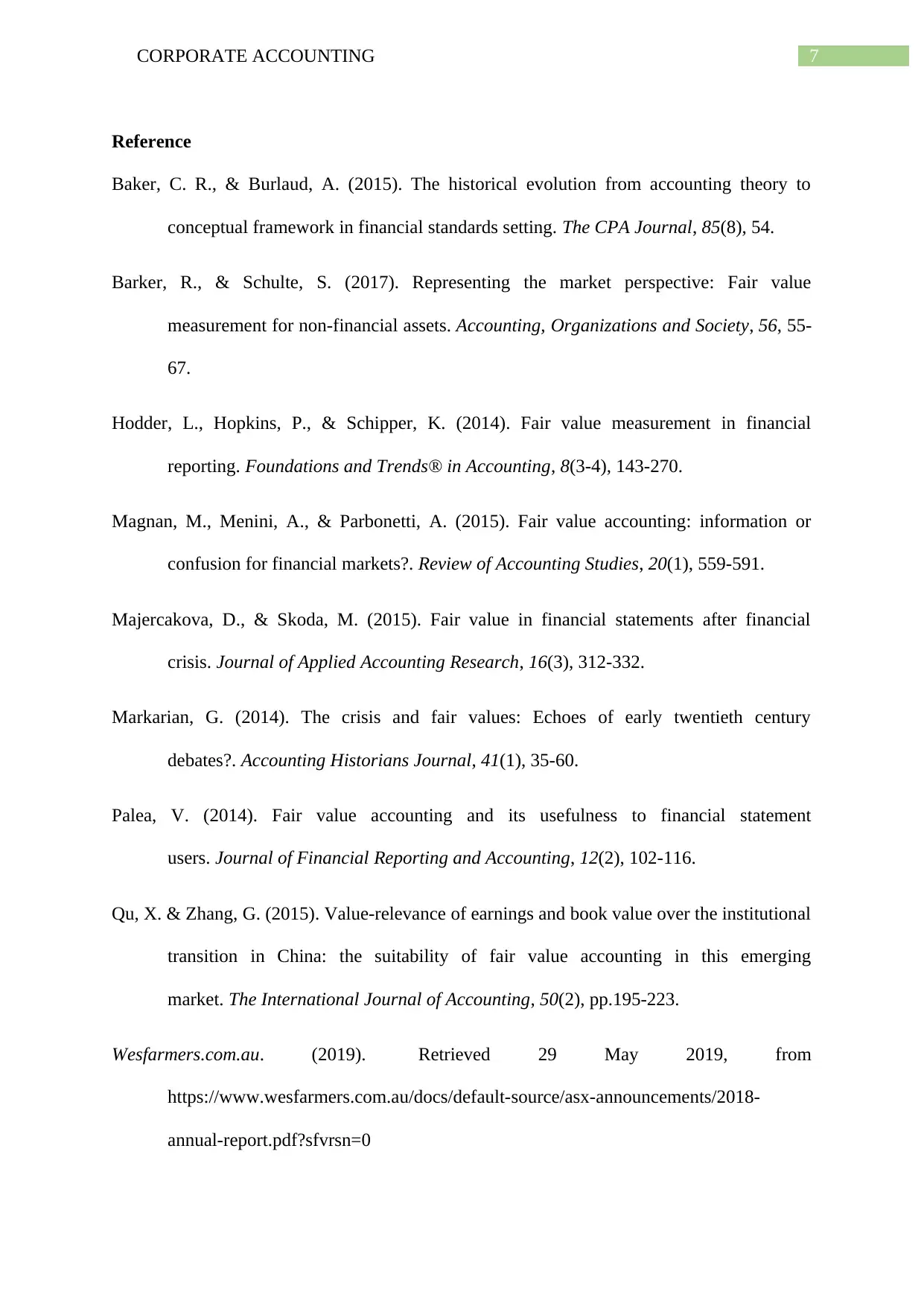
7CORPORATE ACCOUNTING
Reference
Baker, C. R., & Burlaud, A. (2015). The historical evolution from accounting theory to
conceptual framework in financial standards setting. The CPA Journal, 85(8), 54.
Barker, R., & Schulte, S. (2017). Representing the market perspective: Fair value
measurement for non-financial assets. Accounting, Organizations and Society, 56, 55-
67.
Hodder, L., Hopkins, P., & Schipper, K. (2014). Fair value measurement in financial
reporting. Foundations and Trends® in Accounting, 8(3-4), 143-270.
Magnan, M., Menini, A., & Parbonetti, A. (2015). Fair value accounting: information or
confusion for financial markets?. Review of Accounting Studies, 20(1), 559-591.
Majercakova, D., & Skoda, M. (2015). Fair value in financial statements after financial
crisis. Journal of Applied Accounting Research, 16(3), 312-332.
Markarian, G. (2014). The crisis and fair values: Echoes of early twentieth century
debates?. Accounting Historians Journal, 41(1), 35-60.
Palea, V. (2014). Fair value accounting and its usefulness to financial statement
users. Journal of Financial Reporting and Accounting, 12(2), 102-116.
Qu, X. & Zhang, G. (2015). Value-relevance of earnings and book value over the institutional
transition in China: the suitability of fair value accounting in this emerging
market. The International Journal of Accounting, 50(2), pp.195-223.
Wesfarmers.com.au. (2019). Retrieved 29 May 2019, from
https://www.wesfarmers.com.au/docs/default-source/asx-announcements/2018-
annual-report.pdf?sfvrsn=0
Reference
Baker, C. R., & Burlaud, A. (2015). The historical evolution from accounting theory to
conceptual framework in financial standards setting. The CPA Journal, 85(8), 54.
Barker, R., & Schulte, S. (2017). Representing the market perspective: Fair value
measurement for non-financial assets. Accounting, Organizations and Society, 56, 55-
67.
Hodder, L., Hopkins, P., & Schipper, K. (2014). Fair value measurement in financial
reporting. Foundations and Trends® in Accounting, 8(3-4), 143-270.
Magnan, M., Menini, A., & Parbonetti, A. (2015). Fair value accounting: information or
confusion for financial markets?. Review of Accounting Studies, 20(1), 559-591.
Majercakova, D., & Skoda, M. (2015). Fair value in financial statements after financial
crisis. Journal of Applied Accounting Research, 16(3), 312-332.
Markarian, G. (2014). The crisis and fair values: Echoes of early twentieth century
debates?. Accounting Historians Journal, 41(1), 35-60.
Palea, V. (2014). Fair value accounting and its usefulness to financial statement
users. Journal of Financial Reporting and Accounting, 12(2), 102-116.
Qu, X. & Zhang, G. (2015). Value-relevance of earnings and book value over the institutional
transition in China: the suitability of fair value accounting in this emerging
market. The International Journal of Accounting, 50(2), pp.195-223.
Wesfarmers.com.au. (2019). Retrieved 29 May 2019, from
https://www.wesfarmers.com.au/docs/default-source/asx-announcements/2018-
annual-report.pdf?sfvrsn=0
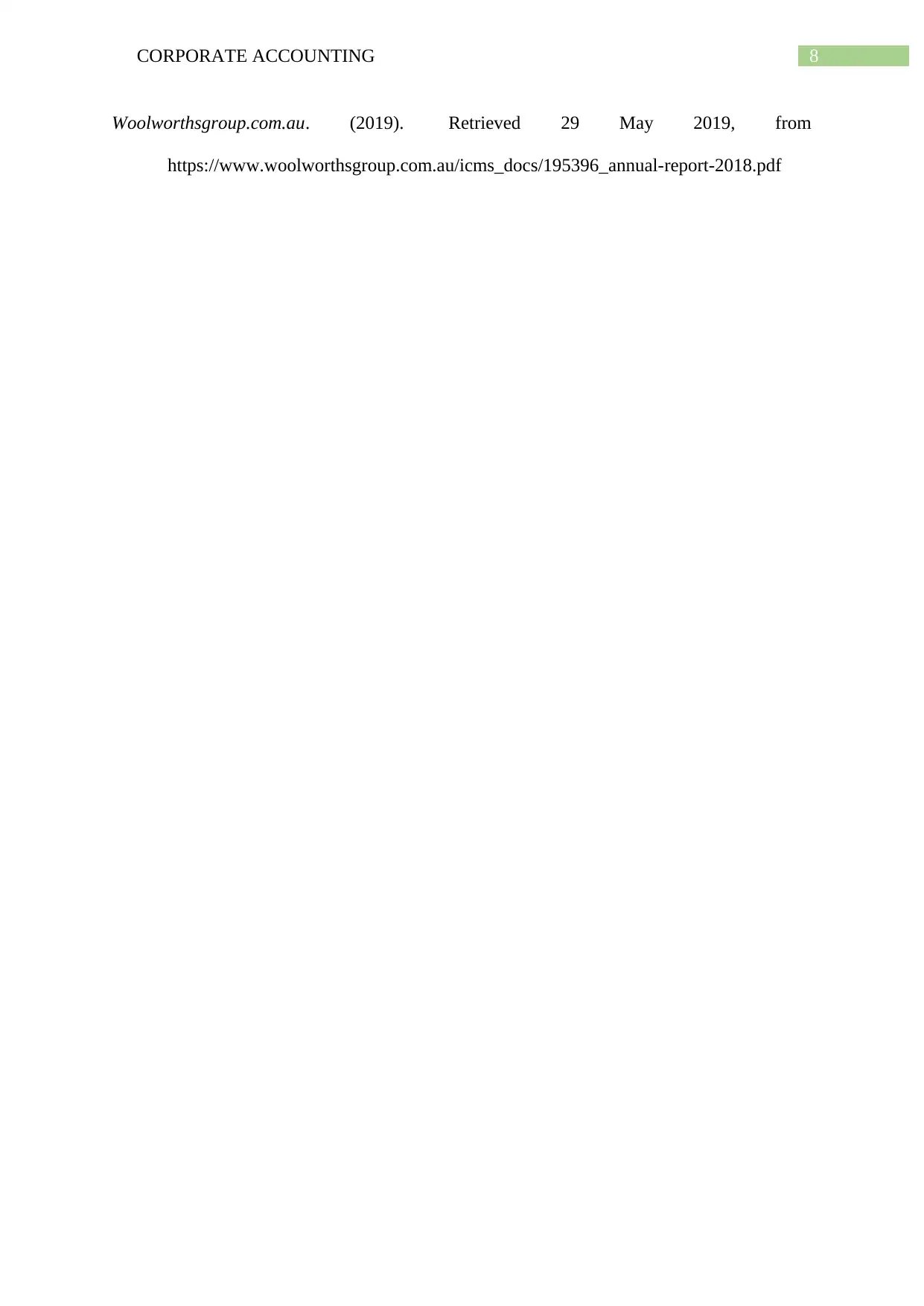
8CORPORATE ACCOUNTING
Woolworthsgroup.com.au. (2019). Retrieved 29 May 2019, from
https://www.woolworthsgroup.com.au/icms_docs/195396_annual-report-2018.pdf
Woolworthsgroup.com.au. (2019). Retrieved 29 May 2019, from
https://www.woolworthsgroup.com.au/icms_docs/195396_annual-report-2018.pdf
⊘ This is a preview!⊘
Do you want full access?
Subscribe today to unlock all pages.

Trusted by 1+ million students worldwide
1 out of 9
Related Documents
Your All-in-One AI-Powered Toolkit for Academic Success.
+13062052269
info@desklib.com
Available 24*7 on WhatsApp / Email
![[object Object]](/_next/static/media/star-bottom.7253800d.svg)
Unlock your academic potential
Copyright © 2020–2025 A2Z Services. All Rights Reserved. Developed and managed by ZUCOL.





